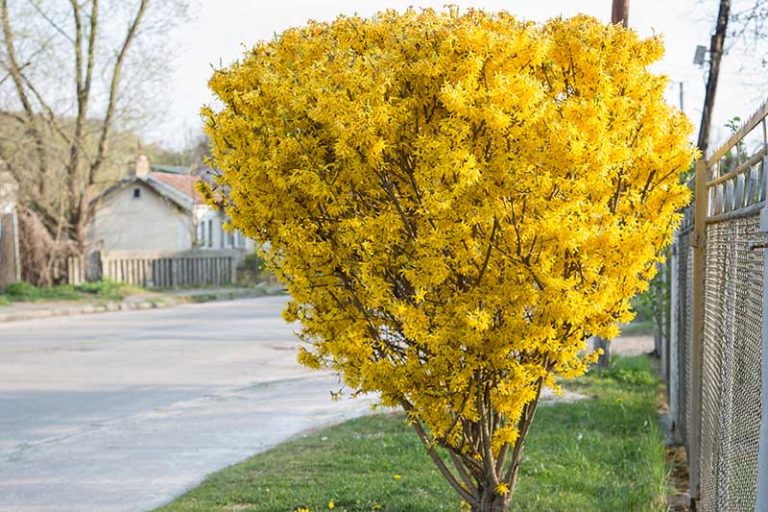Forsythia is a classic spring-blooming shrub beloved for its vibrant yellow flower display. While forsythias are most commonly grown in the landscape these hardy plants can also thrive when grown in containers. With the right pot soil, and care, growing forsythia in pots allows you to highlight its cheerful blossoms on porches, patios, and balconies.
Choosing the Right Forsythia Variety
Forsythia varieties range in size from dwarf shrubs under 3 feet to large varieties up to 10 feet tall. For the best results in containers, choose a dwarf or miniature cultivar that tops out under 4 feet. Some good options include:
-
Forsythia ‘Mini Gold’ – Grows to 2-3 feet tall Profuse yellow blooms,
-
Forsythia ‘Northern Sun’ – Compact 2-3 foot habit Prolific flowers
-
Forsythia ‘Meadowlark’ – Dense dwarf reaches 2-4 feet tall. Abundant blooms.
-
Forsythia ‘Bronxensis’ – Grows just 1-2 feet tall. Blooms spring to fall.
Look for varieties described as compact, dwarf, miniature, or good for containers. Larger forsythia varieties can outgrow pots quickly.
Selecting the Right Container
Choose a container that is just slightly larger than the forsythia’s root ball. This ensures plenty of room for growth while keeping the plant’s size in check.
For most dwarf varieties, start with a 10-14 inch diameter pot. Rectangular or oval planters also work well. Make sure pots have drainage holes to prevent soggy soil.
Use heavy pots that won’t blow over once the shrub is full grown. Plastic, ceramic, concrete, wood, and metal pots all work well. Match the container to your garden style and decor.
Follow Proper Planting Techniques
Forsythias grow best in moist but well-draining soil. When planting in containers, use a quality potting mix amended with compost or organic material. You can also make a customized soil blend.
Set new plants at the same level they were growing in the nursery pot. Firm the soil gently around the roots but avoid excessive compaction. Keep the soil consistently moist after planting to encourage establishment.
Caring for Potted Forsythia Plants
While care is easy, container forsythias need a bit more attention than those planted in the ground:
-
Watering: Check soil daily and water when the top few inches become dry. Don’t let pots completely dry out.
-
Sun: Place pots in full to part sun, with at least 6 hours of direct light for best flowering.
-
Fertilizer: Feed every 2-3 weeks during the growing season with a balanced liquid fertilizer.
-
Pruning: Trim just after flowering while plants are young. Remove up to 1/3 of older stems annually to control size.
-
Overwintering: Move pots to a protected location if temperatures drop below 10°F. Avoid repotting in fall.
With the right variety choice, planting, and care routines, you can successfully grow forsythia shrubs in containers. Position pots on an entryway, patio, or deck to highlight the gorgeous golden blooms up close in spring. Showcase them as stand-alone specimens or combine with early bulbs and perennials. Getting the growing conditions right allows you to enjoy lively forsythia color in small spaces.
Let the Planting Begin!!! Forsythias & Lilacs! // Garden Answer
FAQ
Do forsythia do well in pots?
Does forsythia like sun or shade?
Can you keep forsythia small?
Can forsythia take full sun?
How do you grow a forsythia in a pot?
Place a little of the compost or growing medium in the base of the new container, then place the plant into it and fill in more around the sides. Make sure that the forsythia sits at the same depth within this pot as it did in its previous one so that the compost or growing medium comes up to the same level on the plant.
What are the best Forsythia plants?
Add these forsythia varieties to your landscape: Show Off ® (Forsythia x intermedia) is a compact variety with prolific yellow blooms along the entire length of the stems. The shorter stature and upright branching makes Show Off ® suitable for small urban yards, as hedging or in mass plantings. Plants need little or no pruning.
How many forsythias can you grow in a pot?
Typically, you will grow only one forsythia per pot or container, since even the smaller cultivars will take up quite a lot of space. However, this does not stop you from choosing a container large enough to accommodate a small forsythia shrub with a few other plants around the sides.
Can Forsythia be grown in containers?
When you think of forsythia, you think of large shrubs that cannot be possibly grown in containers, but the good news is that they are small species and varieties that will do well in containers. Forsythia takes its genus name from William Forsyth, a Scottish botanist, who founded the Royal Horticultural Society.
- A Complete Guide to Caring for Yuki Cherry Blossom Shrub - January 23, 2025
- Identifying Red Hot Poker Seeds: What to Look For When Harvesting Torch Lily Pods - January 23, 2025
- A Complete Guide to Harvesting Evening Primrose Seeds - January 23, 2025

